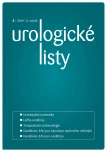Ureteropelvic junction stenosis - antegrade and retrograde endopyelotomy, laparoscopic pyeloplasty. Right indication, pros and cons
Authors:
A. Čermák; D. Pacík
Published in:
Urol List 2008; 6(3): 44-47
Overview
The ideal treatment for ureteropelvic junction (UPJ) obstruction would be minimally invasive with a low complication and failure rate. Treatment modality would achieve the highest success rate, be capable to correct all forms of UPJ stenosis and remove coexisting renal calculi. The minimally invasive options have become widely accepted because of reduced symptoms and preserved or increased renal function. Endourological techniques were established as minimally alternatives to open pyeloplasty and were introduced with the goal to meet the standard of open dismembered pyeloplasty providing the same long term success rates.
This article reviews the current therapeutic options and reviews methods of selection for different treatment modalities.
Key words:
ureteropelvic junction stenosis, minimally invasive surgery, endopyelotomy, laparoscopy, robotic surgery
Sources
1. Murphy LJT. The Kidney. In: The History of Urology. Springfield: Charles C. Thomas Publisher 1972: 197–208.
2. Novick AC, Streem SB. Surgery of the Kidney. In: Walsh PC, Retik AB, Standy TA, Vaughan ED Jr.(eds). Campbell´s Urology, 3. vol, 6. ed. Philadelphia: WB Saunders 1992: 2413–2500.
3. Wickham JE, Kellet MJ. Percutaneous pyelolysis. Eur Urol 1983; 9(2): 122–124.
4. Wickham JEA. Percutaneous pyelolysis. In: Wickham JEA, Miller RA (eds). Percutaneous Renal Surgery. London: Churchill Livingstone 1983: 148–154.
5. Badlani G, Eshghi M, Smith AD. Percutaneous surgery for ureteropelvic junction obstruction (endopyelotomy): technique and early results. J Urol. 1986; 135(1): 26–28.
6. Inglis JA, Tolley DA. Ureteroscopic pyelolysis for pelviureteric junction obstruction. Br J Urol 1986; 58: 250–252.
7. Danuser H, Ackermann DK, Bohlen D, Studer UE. Endopyelotomy for primary ureteropelvic junction obstruction: risk factors determine the success rate. J Urol 1998; 159: 56–61.
8. Van Cangh PJ, Wilmart JF, Opsomer RJ et al. Long-term results and late recurrence after endoureteropyelotomy: a critical analysis of risk factors. J Urol 1994; 151: 934–937.
9. Conlin MJ, Bagley DH. Ureteroscopic endopyelotomy at a single setting. J Urol 1998; 159: 727–731.
10. Van Cangh PJ, Nesa S, Galeon M et al. Vessels around the ureteropelvic junction: significance and imaging by conventional radiology. J Endourol 1996; 10: 111–119.
11. Keeley FX, Moussa SA, Miller J, Tolley DA. A prospective study of endoluminal ultrasound versus computerised tomography angiography for detecting crossing vessels at the ureteropelvic junction. J Urol 1999; 162: 1938–1941.
12. Meretyk I, Meretyk S, Clayman RV. Endopyelotomy: comparison of ureteroscopic retrograde and antegrade percutaneous techniques. J Urol 1992; 148(3): 775–783.
13. Motola JA, Badlani GH, Smith AD. Results of 212 consecutive endopyelotomies: an 8-year followup. J Urol 1993; 149(3): 453–456.
14. Van Cangh PJ, Wilmart JF, Opsomer RJ, Abi-Aad A, Wese FX, Lorge F. Long-term results and late recurrence after endoureteropyelotomy: a critical analysis of prognostic factors. J Urol. 1994; 151(4): 934–937.
15. Renner C, Frede T, Seemann O, Rassweiler J. Laser endopyelotomy: minimally invasive therapy of ureteropelvic junction stenosis. J Endourol 1998; 12(6): 537–544.
16. Danuser H, Ackermann DK, Böhlen D, Studer UE. Endopyelotomy for primary ureteropelvic junction obstruction: risk factors determine the success rate. J Urol. 1998; 159(1): 56–61.
17. Schuessler WW, Grune MT, Tecuanhuey LV, Preminger GM. Laparoscopic dismembered pyeloplasty. J Urol 1993; 150(6): 1795–1799.
18. Janetschek G, Peschel R, Altarac S, Bartsch G. Laparoscopic and retroperitoneoscopic repair of ureteropelvic junction obstruction. Urology. 1996; 47(3): 311–316.
19. Ost MC, Kaye JD, Guttman MJ, Lee BR, Smith AD. Laparoscopic pyeloplasty versus antegrade endopyelotomy: comparison in 100 patients and a new algorithm for the minimally invasive treatment of ureteropelvic junction obstruction. Urology. 2005; 66(5 Suppl): 47–51.
20. Nakada SY, Wolf JS Jr, Brink JA, Quillen SP, Nadler RB, Gaines MV, Clayman RV. Retrospective analysis of the effect of crossing vessels on successful retrograde endopyelotomy outcomes using spiral computerized tomography angiography. J Urol 1998; 159: 62–65.
21. Gupta M, Tuncay OL, Smith AD. Open surgical exploration after failed endopyelotomy: A 12-year perspective. J Urol 1997; 157: 1613–1619.
22. Keeley FX Jr, Moussa SA, Miller J, Tolley DA. A prospective study of endoluminal ultrasound versus computerized tomography angiography for detecting crossing vessels at the ureteropelvic junction. J Urol. 1999; 162(6): 1938–1941.
23. Giddens JL, Grasso M. Retrograde ureteroscopic endopyelotomy using the holmium:YAG laser. J Urol. 2000; 164(5): 1509–1512.
24. Moore RG, Averch TD, Schulam PG et al. Laparoscopic pyeloplasty: experience with the initial 30 cases. J Urol 1997; 157: 459–462.
25. Jarrett TW, Chan DY, Charambura TC, Fugita O, Kavoussi LR. Laparoscopic pyeloplasty: the first 100 cases. J Urol. 2002; 167(3): 1253–1256.
26. Pardalidis NP, Papatsoris AG, Kosmaoglou EV. Endoscopic and laparoscopic treatment of ureteropelvic junction obstruction. J Urol. 2002; 168(5): 1937–1940.
27. Gettman MT, Peschel R, Neururer R, Bartsch G. A comparison of laparoscopic pyeloplasty performed with the daVinci robotic system versus standard laparoscopic techniques: initial clinical results. Eur Urol. 2002; 42(5): 453–458.
28. Danuser H, Ackermann DK, Bohlen D, Studer UE. Endopyelotomy for primary ureteropelvic junction obstruction: risk factors determine the success rate. J Urol 1998; 159: 56–61.
29. Gupta M, Tuncay OL, Smith AD. Open surgical exploration after failed endopyelotomy: A 12-year perspective. J Urol 1997; 157: 1613–1619.
30. Ramsay JW, Miller RA, Kellett MJ, Blackford HN, Wickham JE, Whitfield HN. Percutaneous pyelolysis: indications, complications and results. Br J Urol 1984; 56: 586–588.
31. Savage SJ, Streem SB. Simplified approach to percutaneous endopyelotomy. Urology 2000; 56: 848– 850.
32. Combe M, Gelet A, Abdelrahim AF, Lopez JG, Dawahra M, Martin X, Marechal JM, Dubernard JM. Ureteropelvic invagination procedure for endopyelotomy (Gelet technique): review of 51 consecutive cases. J Endourol 1996; 10: 153–157.
33. Ono Y, Ohshima S, Kinukawa T, Sahashi M, Yamada S. Endopyeloureterotomy via a transpelvic extraureteral approach. J Urol 1992; 147: 352–355.
Labels
Paediatric urologist UrologyArticle was published in
Urological Journal

2008 Issue 3
Most read in this issue
- Ureteropelvic junction stenosis - antegrade and retrograde endopyelotomy, laparoscopic pyeloplasty. Right indication, pros and cons
- Current scope of ureteroscopy
- Renal calculi burden – percutaneous lithitripsy or retrograde surgery?
- Orthotopic neobladder – an update
